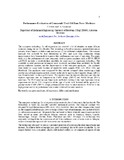Performance evaluation of commonly used oil ram press machines

View/
Date
2007Author
Uziak, J.
Loukanov, I. A.
Publisher
CIGR Journal http://www.cigrjournal.org/Rights holder
CIGR JournalType
Published ArticleMetadata
Show full item recordAbstract
The ram-press technology for oil expression has received a lot of attention in many African countries during the last two decades. The technology is based on manually operated mechanical
presses, which employ a slider-crank mechanism in two different configurations. The original machine was invented by Karl Bielenberg in 1985 and since then continuous design improvements have been made to improve their performance and ease of operation. This paper deals with the performance of some commonly used ram press machines such as BP-35, BP-30 and FI-32, in order to establish their suitability for small rural oil expression technology. The available oil-seed processing techniques were discussed, including their suitability for locally grown sunflower varieties, and the characteristics of the ram press machines. The machines were tested by using three varieties of sunflower seeds, namely PNR 7225, PNR 7369, and Peredovik. The machines were compared by their outputs obtained when conducting a high production and high expression tests. Based on the above analysis the Camartec design (BP-30) was found to have the best performance. The machine had the highest efficiency and also the highest expression rate in comparison to CAPU design (BP-35) and RAM design (FI-32) machines. The FI-32 machine was found to be ineffective, having in the high expression test an
expression rate below 20% irrespective of the type of seeds used. In terms of the speed of oil production the CAPU (BP-35) design performed better then the other machines. However in the high production test its performance was similar to that of Camartec machine.
